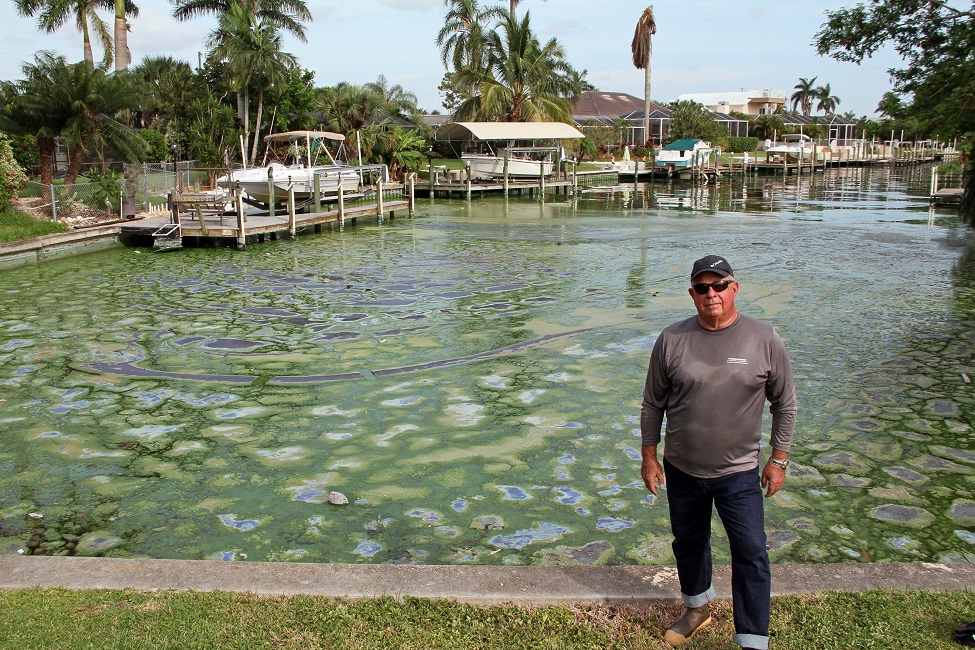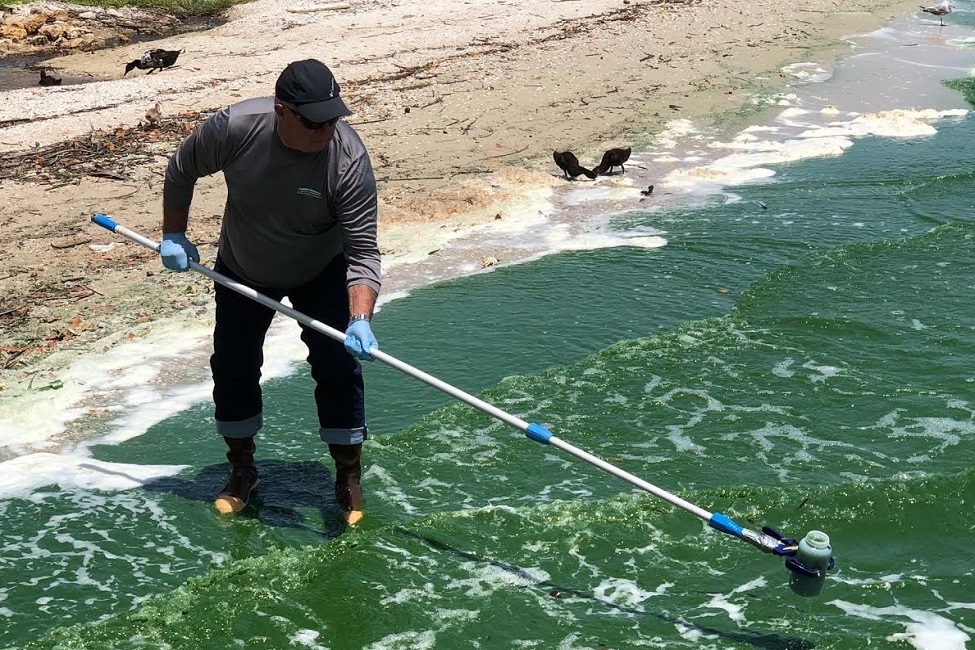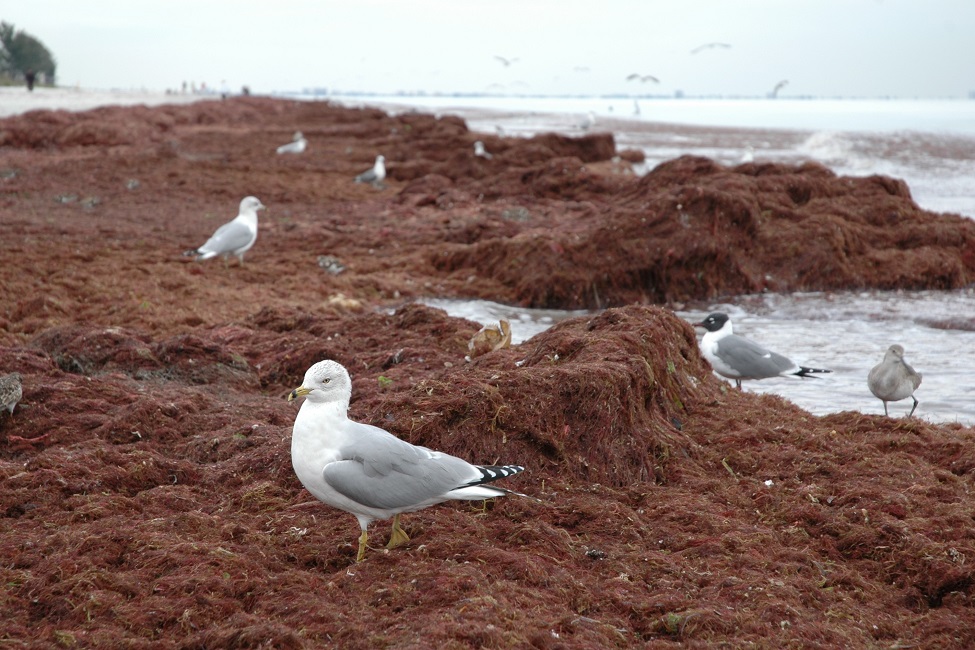Water Quality Woes in S.W. Florida Linked to Seeping Septic Systems

Brian Lapointe, Ph.D., stands in front of a canal in Cape Coral located in Lee County, Florida.
From fecal bacteria to blue-green algae to red tides, Southwest Florida’s water quality has declined as its population has increased. Researchers from Florida Atlantic University’s Harbor Branch Oceanographic Institute took a deep dive into this region’s degrading water quality. Multiple lines of evidence from their multi-year microbial source tracking study point to septic systems as a contributing source for this decline.
Florida’s coastal regions are particularly vulnerable to pollution from septic systems because of shallow water tables and porous soils. Yet, there are about 39,768 “known” and about 57,054 “likely” septic systems in Southwest Florida’s Lee County (about 100,000 total). To identify sources of pollution contributing to the water quality woes, researchers examined septic system- groundwater- surface water couplings through the analysis of various parameters.
In collaboration with the Lee County Department of Natural Resources, researchers measured nutrient and bacteria levels, and employed a suite of microbial source tracking tools related to fecal indicator bacteria to discern the presence of human versus animal feces. They used molecular markers for humans, birds and ruminants (cows, deer, goats, etc.) coupled with chemical tracers that included the artificial sweetener sucralose, pharmaceuticals, herbicides and pesticides. Sucralose, the over-the-counter pain reliever acetaminophen, and the prescription anticonvulsants carbamazepine and primidone were used as indicators of human waste contamination. Groundwater and phytoplankton stable isotopes serve as a reliable tracer of nutrient sources and were measured throughout the study and during red tide and Microcystis spp. harmful algal bloom events.
Results, published in the journal Science of the Total Environment , showed the nutrient and microbial couplings between septic systems, groundwater, surface water, and harmful algal blooms in the highly modified Caloosahatchee River Estuary on the southwest Gulf Coast of Florida and downstream coastal waters. These human waste contaminant sources remained relatively consistent over time with location generally being the most influential factor for water quality. This study is one of few to connect downstream harmful algal blooms with nutrient loading from upstream septic systems.
“This connectivity between septic systems, groundwater and surface water is supported by the significant positive correlations between fecal indicator bacteria and human waste tracers we observed in surface water during outgoing tides,” said Rachel Brewton, first author, a research scientist at FAU Harbor Branch, and a geosciences Ph.D. candidate in FAU's Charles E. Schmidt College of Science. “For example, enterococci and E. coli were positively correlated with carbamazepine, primidone and sucralose, while acetaminophen was weakly correlated with both.”
In each watershed, researchers found several lines of evidence that indicated septic systems were adversely affecting water quality. Notably, shallow water tables demonstrated that many of these systems, installed prior to current septic system design standards, did not have the physical separation required for adequate treatment of human waste. Due to elevated seasonal high water tables, many septic systems in Florida may not meet the state regulatory requirements. Thus, septic systems may actually be sitting in groundwater, during certain times of the year, which means that they cannot function properly.
“These water quality issues in North Fort Myers are caused by aging septic systems installed in high densities in areas with shallow water tables. In addition, the presence of canals in these residential areas with septic systems may increase the rate of pollutant transfer from groundwater to surface water via tidal pumping,” said Brian Lapointe, Ph.D., senior author and a research professor at FAU Harbor Branch. “Based on our previous research, we suspected that waste from septic systems was an important source of nutrient and bacterial pollution in North Fort Myers, and therefore location would be a more important factor for water quality than temporal factors, such as project year or season.”
Indeed, evidence of human waste contamination was observed in all three affected watersheds in the study and included high ammonium concentrations in groundwater and surface water, enriched nitrogen isotope values of groundwater and phytoplankton that closely matched septic system discharge, and elevated surface water fecal indicator bacteria with the presence of HF183, a human-associated marker gene, as well as detections of sucralose, carbamazepine and primidone in groundwater and surface water.
Additionally, researchers found the presence of herbicides and pesticides in surface water, providing evidence that stormwater runoff was adversely affecting surface water quality. Further, detections of molecular markers indicated that fecal matter from birds also may negatively affect water quality at some sites in North Fort Myers. These findings may be useful for understanding water quality and harmful algal bloom drivers in other waterfront communities.
“Stormwater management improvements and citizen education campaigns on subjects including not feeding wild birds, proper removal of pet waste, and judicious fertilizer use may be other methods to help minimize the effect of urbanization on water quality,” said Brewton.
There are many ecological effects of nutrient loading to the downstream estuary. The nitrogen isotope values of coastal red tides closely matched that of septic system discharge, pointing to human waste as a driver of these worsening harmful algal blooms. Poor water quality threatens seagrasses that the vulnerable Florida manatee depends on for survival, which is especially important with the recent unusual mortality events. Additionally, the critically endangered smalltooth sawfish uses the remaining natural shoreline along the Caloosahatchee River Estuary as essential habitat. Aside from the ecological and human health effects, these harmful algal blooms can negatively impact local economies through increased mortality and reduced sales of commercial seafood and by inhibiting ecotourism activities.
“It would be beneficial for coastal areas with high densities of septic systems and canals to be prioritized for septic-to-sewer conversions or other advanced wastewater treatment options,” said Lapointe. “Furthermore, the susceptibility of these systems to localized harmful algal blooms may be reduced by balancing the ecological stoichiometry of the watershed to achieve a nutrient load and nitrogen-to-phosphorus ratio where these microalgae will not thrive, leading to fewer harmful algal blooms events. As other recent research has noted, the scale of the red tide issue demands watershed-scale solutions and nitrogen management based on a holistic view, considering both oceanographic and anthropogenic processes.”
//
From fecal bacteria to blue-green algae to red tides, Southwest Florida’s water quality has declined as its population has increased.
Study co-authors are Lisa B. Kreiger, operations manager, Lee County Department of Natural Resources; Kevin N. Tyre, a water research scientist; Diana Balidi, a marine biologist and environmental scientist; Lynn E. Wilking, a marine biologist; and Laura W. Herren, a biological scientist at FAU Harbor Branch.
This work was funded by United States Environmental Protection Agency 319 grant administered through the Florida Department of Environmental Protection (FDEP agreement NF047) with matched funding provided by Lee County. Additional support was provided by the Florida Center for Coastal and Human Health, which was developed with a grant from and continually funded by the Harbor Branch Oceanographic Institute Foundation, and the U.S. National Aeronautics and Space Administration (NASA) Water Resources Program (80NSSC19K1200).

Brian Lapointe, Ph.D., collects water samples in Lee County, Florida.

Red drift algae along a beach in Lee County, Florida
-FAU-
Latest Research
- FAU BEPI: Economic Strain Hits Hispanic Households Hard in 3rd QuarterHispanic consumer confidence dropped in the third quarter of the year as uncertainty and increased prices placed added pressure on their budgets, according to a poll from Florida Atlantic University's BEPI.
- FAU's Queen Conch Lab Receives Prestigious International AwardFAU Harbor Branch researchers have received the 2025 Responsible Seafood Innovation Award in Aquaculture from the Global Seafood Alliance for its Queen Conch Lab's pioneering work in sustainable aquaculture.
- After Cancer: Study Explores Caring-Healing Modalities for SurvivorsResearch from FAU's Christine E. Lynn College of Nursing highlights how caring-healing methods like mindfulness can ease distress and build resilience in cancer survivors.
- FAU Researchers 'Zoom' in for an Ultra-Magnified Peek at Shark SkinWhat gives shark skin its toughness and sleek glide? Tiny, tooth-like denticles. Researchers used electron microscopy to reveal how these structures shift with age, sex, and function in bonnethead sharks.
- FAU Lands $3M Federal Grant to Prevent Substance Use in At-risk Youth"Rising Strong" will support more than 3,000 South Florida youth with trauma-informed, evidence-based prevention, empowering vulnerable populations to build resilience and choose substance-free futures.
- FAU Research: Logistics Expansion Slows as Transportation Prices DropThe Logistics Managers' Index had the lowest overall reading since March as the supply chain reacts to economic uncertainty, according to researchers from Florida Atlantic University and four other schools.






